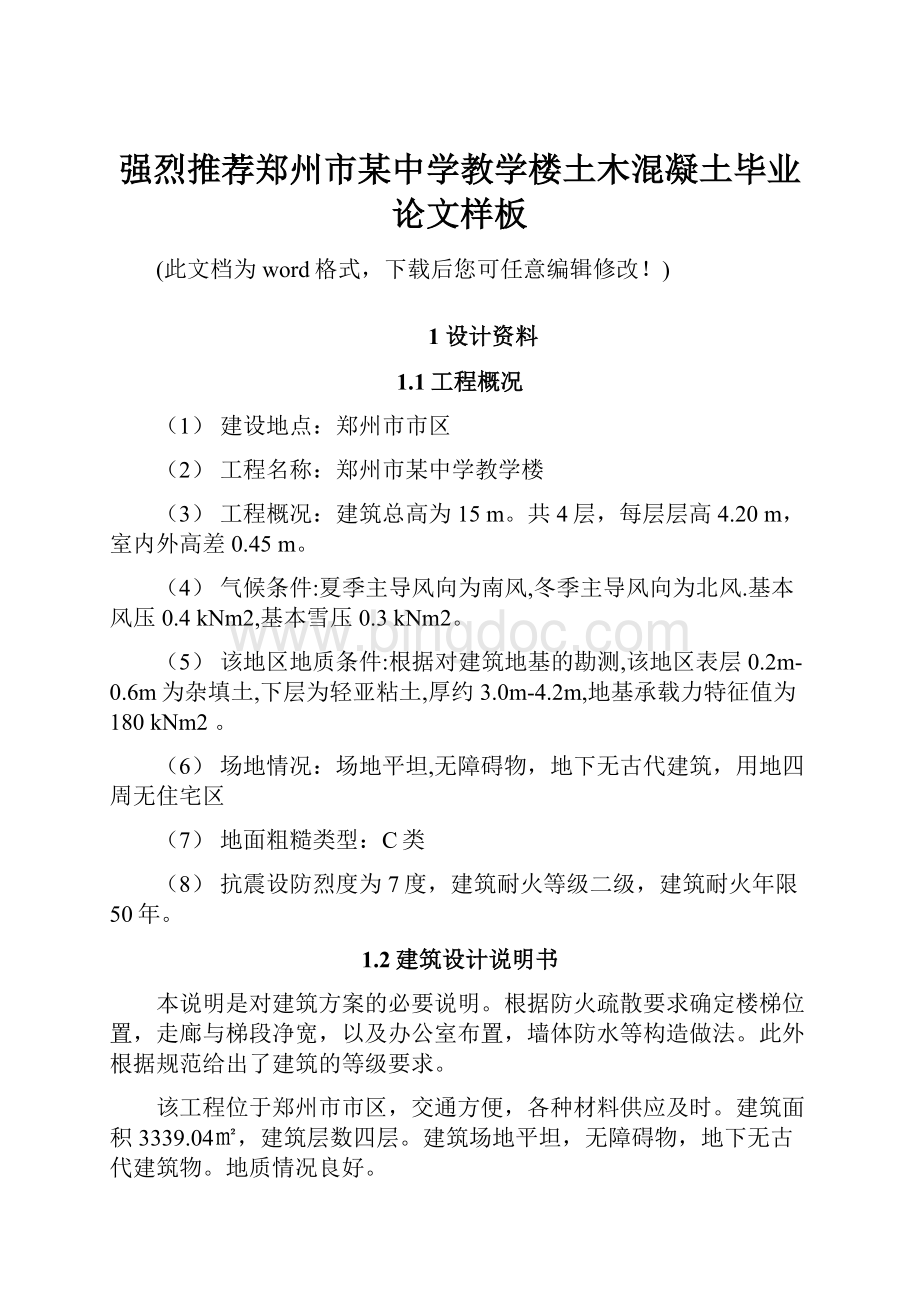强烈推荐郑州市某中学教学楼土木混凝土毕业论文样板.docx
《强烈推荐郑州市某中学教学楼土木混凝土毕业论文样板.docx》由会员分享,可在线阅读,更多相关《强烈推荐郑州市某中学教学楼土木混凝土毕业论文样板.docx(12页珍藏版)》请在冰点文库上搜索。

强烈推荐郑州市某中学教学楼土木混凝土毕业论文样板
(此文档为word格式,下载后您可任意编辑修改!
)
1设计资料
1.1工程概况
(1)建设地点:
郑州市市区
(2)工程名称:
郑州市某中学教学楼
(3)工程概况:
建筑总高为15m。
共4层,每层层高4.20m,室内外高差0.45m。
(4)气候条件:
夏季主导风向为南风,冬季主导风向为北风.基本风压0.4kNm2,基本雪压0.3kNm2。
(5)该地区地质条件:
根据对建筑地基的勘测,该地区表层0.2m-0.6m为杂填土,下层为轻亚粘土,厚约3.0m-4.2m,地基承载力特征值为180kNm2。
(6)场地情况:
场地平坦,无障碍物,地下无古代建筑,用地四周无住宅区
(7)地面粗糙类型:
C类
(8)抗震设防烈度为7度,建筑耐火等级二级,建筑耐火年限50年。
1.2建筑设计说明书
本说明是对建筑方案的必要说明。
根据防火疏散要求确定楼梯位置,走廊与梯段净宽,以及办公室布置,墙体防水等构造做法。
此外根据规范给出了建筑的等级要求。
该工程位于郑州市市区,交通方便,各种材料供应及时。
建筑面积3339.04㎡,建筑层数四层。
建筑场地平坦,无障碍物,地下无古代建筑物。
地质情况良好。
1.2.1设计依据
(1)建设行政主管部分对本项目的批复文件。
(2)与甲方签订的设计合同及经甲方同意的建筑方案。
(3)现行国家有关建筑工程设计规范、标准:
《中小学建筑设计规范》(GBJ99-86(2001版))
《建筑设计防火规范》(GBJ16-87(2001版))
1.2.2方案说明
(1)该工程为郑州市某中学教学楼,建筑结构形式为钢筋混凝土框架结构建筑主体高度为15.000m,基础形式为条形基础。
(2)本设计中柱距为7.20m,进深为6.60m,楼梯开间为3.6m。
(3)按二级防火要求,楼梯设在了建筑的两端,且在建筑的两端均有安全出口,满足防火要求。
(4)本工程±0.000相对于绝对标高值(黄海系)104.51。
(6)本设计中建筑长50.900m,在建筑左侧设有厕所,厕所地面低于同层教室地面30mm。
(7)为了防潮和预防洪水季节雨水进入室内,设室内外高差,高差450mm。
(8)为了采光通风满足要求,窗地比均大于17,窗台高900mm。
(10)屋面防水采用三级防水,不上人屋面。
1.2.3等级说明
(1)根据建筑抗震设计规范,本工程为丙类建筑。
(2)本工程安全等级为二级,设计使用年限为50年。
(3)本工程抗震设防烈度为7度,设计基本地震加速度值为0.15g。
设计地震分组为第一组;场地类别为Ⅱ类。
(4)建筑物抗震等级:
框架为3级。
(5)本工程地基基础设计等级为丙级。
(6)本建筑物防火等级为二级。
1.2.4建筑设计说明及构造做法
(1)长度单位毫米为mm,标高单位米为m。
(2).本工程共四层,室内外高差-0.45m,首层室内地坪标高±0.000m,建筑总标高15.000m。
(3).建筑材料:
现浇的框架柱、梁、板、楼梯间混凝土均为C30,梁柱受力筋HRB335,箍筋HPB235,所有的板钢筋HPB235,外墙加气混凝土砌块250mm宽,内墙加气混凝土砌块200mm。
(4)卫生间:
地面低于同层楼地面30mm,向地漏找坡1%。
地面采用防滑地砖,墙面采(5)屋面做法:
屋面做法详见中南98ZJ001屋16;
楼地面做法:
楼地面做法详见中南98ZJ001楼6;
(6)各房间内墙面做法采用混合砂浆墙面,做法详见中南98ZJ001内墙4。
(7)四层楼梯间设有通向屋顶的通道,屋顶要开检修孔800mm×800mm。
(8)落水管直径为100mm。
1.3结构说明书
1.3.1工程概况
(1).本工程为现浇混凝土框架结构,房屋高度详见建筑图,基础为钢筋混凝土条形基础。
(2).根据国家现行规定,本工程建筑结构按7度三级抗震设防,基本风压为0.40kNm²,结构设计使用年限为50年。
(3).设计基本地震加速度为0.15g,设计地震分组为第一组,抗震设防类别为丙类,场地类别为II类,建筑结构安全等级为二级,基础设计的等级为丙级。
(4).依据规范、规程、标准
1.3.2设计楼面活荷载
(1)不上人屋面:
0.5kNm²
(2)楼面及卫生间:
2.0kNm²
(3)走廊、楼梯:
2.0kNm²
1.3.3材料
(1).混凝土等级:
所有混凝土的强度等级都为C30.
(2).钢筋:
HPB235(A)、HRB335(B)、HRB400(C)
(3).墙体:
±0.000以上填充墙采用加气混凝土砌块,M5混合砂浆砌筑。
1.3.4楼板
(1).板的设计说明详见各结施图及国家建筑标准设计图集《混凝土结构施工图平面整体表示方法制图规则和构造详图》(03G101-1)
(2).板的混凝土保护层厚度均为20mm。
(3).HPB235钢筋所注长度不包括弯钩长度.锚固长度为24d,板中受力筋的短向钢筋放在长向钢筋之上
1.3.5梁、柱
(1).梁、柱的设计说明详见各结施图及国家建筑标准设计图集混凝土结构施工图平面整体表示方法制图规则和构造详图》(03G101-1)
(2).混凝土保护层厚度均为35mm
(3)混凝土柱锚入基础梁的钢筋应在基础施工时预埋,预埋钢筋的直径数量同上部柱
1.3.6墙体
(1).填充墙的长度>5m时,每隔3-4m在墙中设200X墙厚砼构造柱,柱主筋上下分别锚
(2)女儿墙在每一相交轴线上均设250X250混凝土构造柱
1.3.7构造柱
(1).构造柱纵筋锚于基础内直段长度>la,并弯直钩>250mm直钩.纵筋层间搭接长度>la,箍筋为@100,且加密高度不能小于500
(2).穿楼面的构造柱,纵筋在穿楼面处应上下贯通,在楼面以上才能搭接;
(3).墙与柱连接处沿柱高每@500mm设2^18拉结筋,拉结筋伸入墙体内长度不小于1000mm,遇门窗洞按实际长度截取,钢筋伸入柱内不少于210mm.
1.3.8其他
(1)卫生间及管井周边均做混凝土反边,宽度同墙;
(2)所有设备基础均以厂家订货为准,且待设备到货核实后方可施工。
(3)未经技术鉴定或设计许可,不得改变结构的用途和使用环境。
2结构的选型和布置
2.1结构选型
本建筑只有4层,且功能较少,为方便布置房间和便于管理采用大柱网框架结构。
为使结构有较大的刚度本设计中楼面、屋面、楼梯等均采用现浇结构;基础为柱下单向条形基础。
2.2结构布置
本设计中柱距为7.2m。
根据结构布置,本建筑平面均为双向板。
本建筑由于楼面活荷载较大,楼面板和屋面板厚度取120mm。
材料选用:
混凝土:
C30
钢筋:
纵向受力钢筋采用热扎钢筋HRB335,HRB400;其余采用热扎钢筋HPB235。
墙体:
内外墙均采用粉煤灰轻渣空心砌块390×240×190,重度=7KNm3.
窗:
钢塑门窗,=0.35KNm2.
门:
木门
具体情况见结构布置图2-1。
图2-1结构平面布置图
2.3初估梁柱截面尺寸
2.3.1按大跨度进行计算
纵向框架梁:
BasedonDead
LoadRedistribution:
Methodology
HarryW.ShentonIII,A.M.ASCE1;andXiaofengHu2
Abstract:
Anewmethodfordamageidentificationinlarge,massivecivilstructuresispresented,whichisbasedontheideathatdeadloadisredistributedwhendamageoccursinthestructure.Themethodusesstaticstrainmeasurementsduetodeadloadonlyasinputtotheidentificationprocedure.Ananalyticalmodelofafixed-fixedbeamisdevelopedinwhichthedamageisrepresentedbyasectionofreducedflexuralrigidity.Thedamagestateisdeterminedbythelocation,length,andseverityofthestiffnessreduction.Aforwardanalysisofthebeamresponseisfirstpresentedtoillustrateproblemandissolvedusingageneticalgorithm.Theproposedmethodcorrectlyidentifieddamageinthebeamforawiderangeoflocationsanddamageseverities.Theidentificationprocedure,ingeneral,itisclosetotheinflectionpointoftheundamagedbeam,wherethedeadloadstrainiszero.Theeffectofmeasurementnoiseontheabilitytoidentifydamageisinvestigatedinthecompanionpaper.
CEDatabasesubject;Strain;Damage.
Introduction:
Structuralofadvancedtechnologiestotheautomateddetectionandassessmentofdeteriorationordamageinastructuralsystem.Theconcept,whichinrecentyears,involvestheuseofadvancedsensors,microprocessors,communicationsystems,andalgorithmstoautomaticallysense,locate,assess,diagnose,andreportontheconditionofastructuralsystem.Appliedtoacivilstructure,astructureduetosustainedloadorenvironmentalfactors,andortodetectrapidchangesduetorare,earthquake,beutilizedonanas-neededbasis,oraspartofapermanent,long-termcangenerallybeclassifiedaseitherdynamic-orstatic-basedtechniques.Themorepopulardynamictechniquesarebasedonthepremisethatwhenastructureisdamaged,theassociatedchangeinthestructurewillresultinachangeinthenaturalfrequencies,modeshapes,dampingratios,modalstrainenergies,orotherdynamiccharacteristicsofthesystem.Bymeasuringoneormoreofthesepropertiesofthedamagedstructure(andinsomecasestheundamagedstructure)thelocationandextentofdamagecouldbeidentified.Thedynamicproceduresrequiresometypeofdynamicexcitation;themostpopularareambientvibration,impulseresponse,andforced.Accelerationsareusuallymeasuredinthedynamic-basedtechniques.
Atremendousamountofworkconductedondamagedetectionbasedondynamicresponses.Doeblingetal.(1996)providesacomprehensiveliteraturereviewoftheworkinthisarea.Thereviewisupdatedforliteraturepublishedbetween1996and2001,inSohnetal.(2003).
Whilesomeappliedtolarge,massive,civilstructures.First,itisverydifficulttoexcitealargestructuretoalevelthatv,illelicitchangesinthesignaloutputsresultingfromlocalizeddamage.Itisoftenimpracticalandtooexpensivetoattempttoexcitethestructureatallinacontrolledway,andtherefore,manydynamictechniquesrelyonambientvibrations.Second,inanambientvibrationsurveytheexcitationisprovidedbyasources.Thesesamesourcesarepresentinaforcedvibrationtest,butareusuallynotmeasuredoraccountedforintheanalysisand"excitation.Third,fieldteststhatthevariabilityofthetestdatafromreplicatetestsconductedondifferentdays,duetosuchthingsastemperatureandextraneousexcitationsources,canbeofthesameorderofmagnitudeasthechangesduetothedamageimposed;thusthedamagecouldnotbesuccessfullyidentified(FmTarandDoebling1997).
Static-basedtechniquesworkunderasimilarpremiseasthedynamic-basedtechniques,onl5usingstaticexcitationsandmeasuredresponses.Inthiscaseastaticloadisappliedtothestructureandtheresponse,typicallydisplacementorstrain,ismeasuredatoneormorelocations.SanayeiandOnipede(1991)usedafiniteelementmodelandmeasureddeflectionstodeterminethestiffnesspropertiesofthestructure.Bananetal.(1994a,b)developedaframeworkforidentifyingparametersinastructurebasedonstaticresponsequantities.Theproblemwascastasaconstrained,nonlinearminimizationproblem,usingeitheraforce-errorestimatororadisplacement-errorestimator.Theproblemwassolvedbyrecursivequadraticprogramming.Theprocedurewastestedona25memberBowstringtruss.HjelmstadandShin(1997)usedasimilarapproachalongwithanadaptiveparametergroupingschemeandadataperturbationschemetoaddresstheproblemsofsparceandnoisydata.SanayeiandSaletnik(1996a,b)modifiedtheproceduredevelopedearlierbySanayeiandOnipede(1991)tousestaticstrainmeasurementsinsteadofdisplacements.Parameterswereestimatedbyminimizingtheerrorbetweenthetheoreticalandmeasuredstrainsinthestructureresultingfromaseriesofconcentratedforces.LiuandChian(1997)developedaprocedureforidentifyingthecrosssectionalareasofatrussusingstaticstrainmeasurementsresultingfromaseriesofconcentratedforces.Aclosed-formsolutionisobtainedforthetruss.Anumericalexampleispresentedalongwithmodeltestresults.Mostrecently,ChouandGhaboussi(2001)usedageneticalgorithmtoidentifydamageinatrussstructurebasedonmeasureddeflections.
Thestatic-basedtechniquesproposedtodatealsofacepracticalchallengeswhenappliedtolarge,civilstructures.First,itisnearlyimpossibletoapplyacontrolledlateralloadtoalargecivilstructure.Thiswouldrequireareactionstructureofsizeequaltothatofthestructureandatremendousforceactuator.Second,someofthetechniquesmentionedusestaticdeflectionmeasurementsintheidentificationprocedure.However,inmostcasesitisimpracticaltomeasuredeflectionsinalargestructure,simplybecausethereisnotafixedabsolutereferencetomakethemeasurementagainst.
Analternativemethodfordamagedetectioninlargecivilstructuresdevelopedthatisaimedateliminatingsomeofthepracticalproblemsassociatedwiththeothermethodsmentionedpreviously.Whiletheprocedurecouldbeusedonan"asneeded"basis,itissuitedmoretowardpermanentlong-termofdeadloadinthestructurethattakesplacewhendamageoccurs.Theprimaryloadcarriedbyalargecivilstructureisitsownweight;inmanycases(take,forexample,alargebridgeinanonseismicregion)theliveloadeffectsareinsignificantrelativetothedeadloadeffects.Oncebuilt,thedeadloadresultsinacertaindistributionofstressinthestructure,whichforallintentandpurposesshouldremainconstantthroughoutthelifeofthestructure.However,whendamageoccurs,whetheritoccursgraduallyorinstantaneously,thiswillresultinaredistributionofdeadloadstressinthestructure.Atthesametimethemagnitu